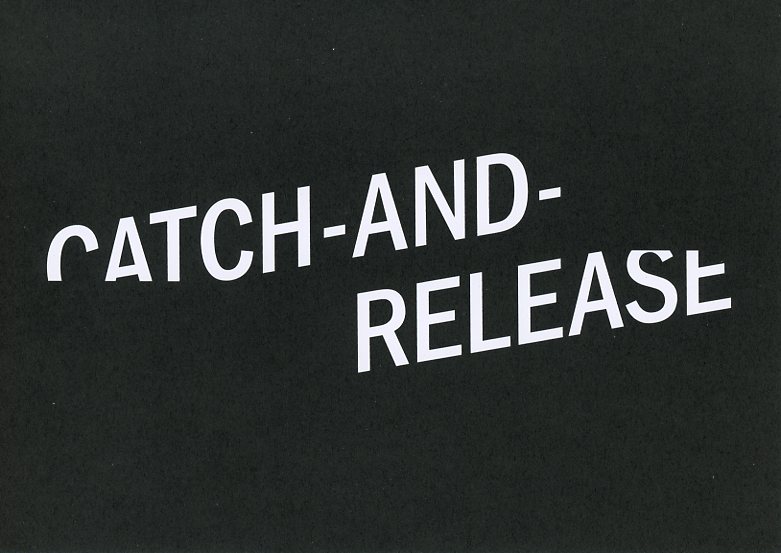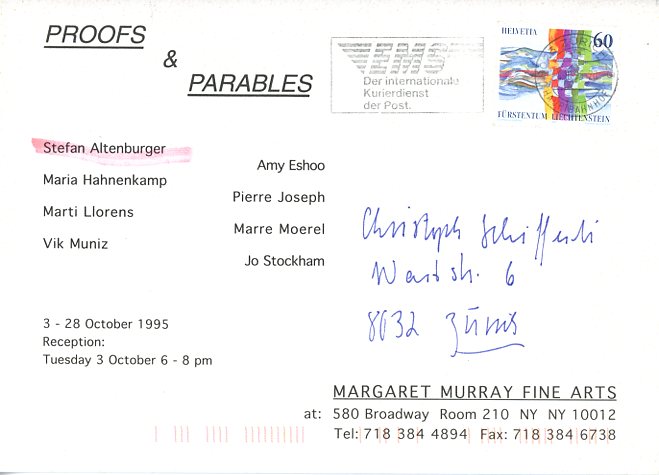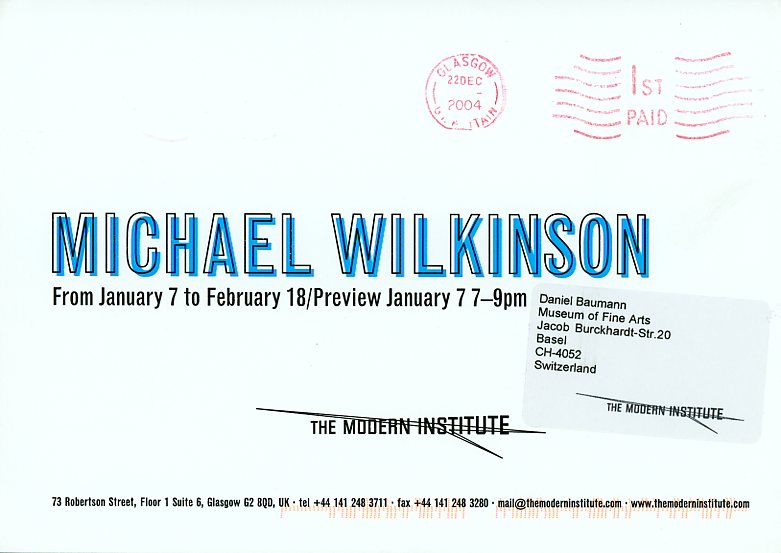

Robert Kinmont (b. 1937, Los Angeles) currently lives in Northern California. Between 1968 and 1981, he exhibited in galleries and institutions such as the San Francisco Museum of Art; the de Young Museum, San Francisco; the Smithsonian Institution, Washington D.C. and the 1968 “Sculpture Annual” at the Whitney Museum, New York. Between 1975 and 2004, Kinmont studied Buddhism and worked as a carpenter, returning to his artistic practice in 2005.
Exhibition announcement for this show at Alexander and Bonin.
Martin Honert



Martin Honert is a German artists born in 1953. He shows at the American gallery Matthew Marks. The gallery sends out some of the best invitation cards, and they certainly deserve a retrospective.
Richard Prince 4 Blue Cowboys


Probably not the most important exhibition by Richard Prince. The four pictures are worth looking at, getting seduced, let’s go there, see here.
Thomas Hirschhorn


Thomas Hirschhorn’s invitation card for his exhibition Concordia, Concordia at Gladstone. On 13 January 2012 at 21:45, the cruise ship Costa Concordia stuck a rock in the Tyrrhenian Sea off the eastern shore of Isola de Giglio. 32 people died.
Press release: Gladstone Gallery is pleased to present the exhibition “Concordia, Concordia” by Thomas Hirschhorn. The exhibition features a large-scale work inspired by the sinking of the cruise ship Costa Concordia, which ran aground off the coast of Italy in January 2012.
Artist’s Statement:
As many people, I saw the pictures showing the inside of the sunken cruise ship Costa Concordia after the wreck. The floor emerging upright had become a wall, the wall was turned into a ceiling and the ceiling into the opposite wall. Every non-attached thing was floating in water, like a barricade in movement. A barricade made of all that points out the impassable and cumbersome inutility. I was struck by this apocalyptic upside down vision of the banal and cheap “nice, fake, and cozy” interior of the overturned ship. This pictures the uncertainty and precariousness of the past, of the present moment, and of the future. I saw it as an amusing and disturbing but nevertheless logical and convincing form. This must be the form of our contemporary disaster. This must be the ultimate expression of the precarious, which nobody wants to confront. “Get back on board, captain!” shouted the coast guard officer to the already safely landed captain of the Costa Concordia who refused to go back to his vessel. “Get back on board!” means there is definitely no escape – we have to confront the self-produced disaster in its incredible normality – there is no way out, there is no place to flee, there is no safe land anymore! This is the starting point that made me think of and start out to conceive the work “Concordia, Concordia.”
I want to do something Big. To do something Big does not mean to do something monumental or gigantic. If something is Big, it’s because it needs to be Big. One must understand that necessity as such or within its own logic. That’s why, when making things Big, I do it myself, with my own hands, with my own materials, with my own visual vocabulary and with my own work. I do it in order to avoid the “Blow-Up” effect and I do it to avoid falling into the trap of “Pumping the Size.” I want to do a Big work to show that the saying “Too Big to Fail” no longer makes any sense. On the contrary, when something is Too Big, it must Fail – this is what I want to give Form to. I want to understand this as a logic and this is the Form! This is what I want to explore, it is the grounding of my new work “Concordia, Concordia.” “Concordia, Concordia” brings back to mind the disastrous wreck of the cruise ship Costa Concordia and the images of the immersed ship in its confusing architecture. The flooded casino of consumption stands for evidence: the evidence of a coming disaster and the evidence of an announced failure. This is “Concordia, Concordia.” – Thomas Hirschhorn
Allen Ruppersberg


The American artist Allen Ruppersberg is certainly underrated. He belongs to the group of artists that may never achieve stardom nor produced a masterwork, except maybe his groundbreaking participatory environments Al’s Cafe (1969) and Al’s Grand Hotel (1971). His work connects time and space by gestures comparable to ephemera.
The Hammer Museum writes on their website: “Ruppersberg moved to Los Angeles in the mid-1960s with the goal of becoming an illustrator, but soon became active in an emerging scene led by artists such as John Baldessari, Ed Ruscha, William Leavitt, and others exploring the interface of language and image filtered through the lens of mass culture. His early projects—including environments made with found objects; wry, narrative photo works; and a novel copied by hand—began a career-long practice of creating works that prompt both reading and looking, and that intertwine fact with fiction.”
User comment by Marina Prodo: “I choose these particular prints because with simple typography and really strong color it has impact, shows a phrase (probably said by the artist) which has humor and it is almost saying (with other words) ‘You have to come or I’ll be deluded’. Also because the sentence ‘Honey’ made me smile! Like the simple and beautiful graphic design as well!” Buy it here!
Darse Comfort










Darse Comfort was a short-lived independent art space in Zürich run by artist Yannic Joray, graphic designer Carmen Tobler, and curators Fredi Fischli and Lorenzo Bernet. Carmen Tobler was the designer of the invitation cards.
Schnittraum / Anja Sopic


in 1997, with a grant to rent a studio space, German artist Corinna Schmitt decided to open an exhibition space instead (not far from the central train station in Cologne). From 1998 to 2000, the curators Yilmaz Dziewior, Anette Freudenberger and Maria Anna Tappeiner joined the team. In 2001, a new team of curators took over (see below). In 2007 Schnittraum turned into a gallery and was run by Lutz Becker until 2009. The exhibition by Anja Sopic must have been one of the last shows.
“Der schnittraum wurde im Juni 1997 gegründet. Mit Hilfe eines Atelierstipendiums der Düsseldorfer Firma North Property Consulting mietete die Künstlerin Corinna Schnitt anstelle eines Ateliers Ausstellungsräume in der Nähe des Kölner Hauptbahnhofes an. Von Sommer 1998 bis Dezember 2000 beteiligten sich die KunsthistorikerInnen Yilmaz Dziewior, Anette Freudenberger und Maria Anna Tappeiner an der Konzeption und Durchführung des Ausstellungsprogramms. Über 30 Ausstellungen und Projekte wurden bisher realisiert. Außerdem wurden Film- und Videoprogramme vorgestellt sowie eine mehrwöchige Projektreihe mit Vorträgen, Performances und Filmvorführungen unter dem Titel SCHNITT AM SAMSTAG durchgeführt. In der Reihe STUDIO 2000 wurden letztes Jahr fünf internationale Künstlerinnen und Künstler eingeladen, den Schnitt Ausstellungsraum als Atelier zu nutzen. Im Anschluss an den Aufenthalt wurde ihre Arbeit in Form von Vorträgen, Präsentationen oder anderen Formen öffentlich gemacht. Mit dem über mehrere Wochen angelegten Ausstellungsprojekt OUT OF SPACE war der Schnitt Ausstellungsraum im Frühjahr 2000 zu Gast im Kölnischen Kunstverein.
2001 hat sich das Kuratorenteam des Schnitt Ausstellungsraums neu formiert: Neben Corinna Schnitt und Maria Anna Tappeiner betreuten dieses Jahr Rosanne Altstatt (geb. USA) und Marjorie Jongbloed (geb. NL) das Programm. Mit JOINT VENTURES und VIDEO AB ACHT wurden zwei neue Projektreihen durchgeführt.
2002 hat sich der Schnittraum noch weiter gegenüber Außenimpulsen geöffnet. In der Reihe TONIGHT – Werkgespräche werden von Corinna Schnitt und Maria Tappeiner vermehrt GastkuratorInnen eingeladen sowie eigenständige Projekte von Künstlergruppen und Einzelpersonen durchgeführt (z.B. Wochenend von Marc Hartmann und Saskia Paul).
Im März 2003 wurde der schnittraum von Sabine Oelze und Lutz Becker übernommen und bis 2006 als nicht-kommerzielles Ausstellungsprojekt geführt.
Von 2007-2009 wurde der Schnittraum unter Leitung von Lutz Becker zur Galerie. Nähere Infos unter www.schnittraum-lutzbecker.de.” Quelle
Stefan Altenburger


Stefan Altenburger most probably sent this invitation card to Christoph Schifferli announcing his new show in New York at Margaret Murray Fine Arts. Murray later run Murray Guy Gallery, which closed the doors of its Chelsea gallery in 2017 after 19 years of exhibitions.
Stefan Banz (1961-2021) on Altenburger: “Like Percy Rainford, Stefan Altenburger is a master of precision and restraint. He puts himself entirely at the service of the subject matter and does everything in his power to do photographic justice to the character and presence of a work of art.” Source
Today, Stefan Altenburger is an established photographer documenting exhibitions and artworks for numerous galleries, museums, and artists. If you google his name, this information shows on wikipedia: “Stefan Altenburger (Zürich, 1968) is a Swiss visual artist who is best known as musician Golden Boy for his collaborations with Miss Kittin such as the club hit “Rippin Kittin.”[1]
The Moderne Institute




















A small selection of the invitation cards by The Modern Institute. Toby Webster established The Modern Institute in 1997 in Glasgow, in partnership with former Tramway and current Van Abbemuseum Director, Charles Esche, and writer and curator Will Bradley. For many years, The Modern Institute sent out these very simple, great, sometimes funny, sometimes conceptual announcements. The gallery’s logo was designed by Toby Webster, so were the cards, and in the very beginning, he hand fed them through a riso machine. As Matthew Marks’ invitation cards, they deserve a retrospective or being part of a design museum. Or both.
As many of the new young galleries established in the mid to late nineties, The Modern Institute (est. 1997) used their invitation cards to highlight individuality and as an innovative form of (self-)branding. Invitation cards could become an art project, and a space where art may happen – and is distributed worldwide for free. A similar strategy was adopted by other young up-and-coming galleries such as neugerriemschneider, Berlin (est. 1994), Gavin Brown’s Enterprise, New York (1994-2020), CFA Contemporary Fine Arts, Berlin (est. 1992), The Modern Institute, Glasgow (est. 1997), Meyer Riegger Galerie (est. 1997 in Karlsruhe, since 2008 also in Berlin) or Eva Presenhuber (Galerie Walcheturm 1989-1998/Galerie Eva Presenhuber).
Rirkrit Tiravanija, Glasgow 1999

Community Cinema For a Quiet Intersection (Against Oldenburg) was an early, community-driven project by Rikrit Tiravanjia in Glasgow 1999. Here some pictures on flickr.
“The Thai artist Rikrit Tiravanja created the installation Community Cinema For a Quiet Intersection (Against Oldenburg) as part of the City of Architecture Festival in Glasgow, Scotland, in September 1999. He created a temporary outdoor cinema composed by four screens and accompanied by a Thai café right on the traffic intersection in a residential neighbourhood in Glasgow and after dusk showed films that had been chosen by the local community: Casablanca, A Bug’s Life, The Jungle Book and It’s a Wonderful Life were shown in parallel on the our screens.” Anna Schober, The Cinema Makers: Public Life and the Exhibition of Difference in South-Eastern and Central Europe Since the 1960s .
 follow
follow